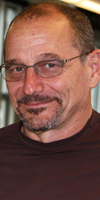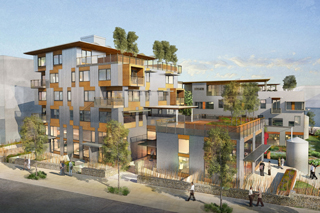|
Subscribe / Renew |
|
|
Contact Us |
|
| ► Subscribe to our Free Weekly Newsletter | |
| home | Welcome, sign in or click here to subscribe. | login |
Environment
| |
 |
February 23, 2012
Live, work and farm at Ballard's Greenfire
Johnston Architects

Johnston
|
Sustainability is more than reducing vehicle miles traveled or developing transit options.
To be sure, these are important parts of the race towards a viable future. But of equal or greater importance is the way in which we interact with each other and the way in which we create and interact with our built and natural environment.
These connections directly affect our physical well-being. We are acknowledging the importance of these interactions in our design of the Greenfire Campus, an office, retail and residential project in Ballard.
An ‘erratic’ presence
Two ideas capture the approach we are taking at the Greenfire Campus: sensible sustainability and social sustainability.
Both seek to maximize what we can achieve in a practical manner. In terms of building technology, sensible sustainability is the idea that we should do what we can in a balanced, practical and affordable way. Social sustainability is the pursuit of a built environment that promotes human interaction.
The Greenfire Campus began with the search for a site. Ideally, the site would house commerce as well as living spaces, it would be part of a neighborhood and it would be an enhancement to the qualities evolving in the neighborhood. In order to promote healthy living, the team also hoped to allow the natural environment to hold sway on part of the site.
The income from the project would be conceived as a dividend over time rather than a short-term profit. Energy-saving strategies would be measured within a multi-decade financial model. Social impacts would be measured by the health of the surrounding community.
A near-acre of asphalt in the heart of Ballard proved to be a perfect location for the project. It was in the center of a growing community, adjacent to public facilities such as a library and park, and part of a block that was in transition.
| Greenfire Campus |
|
Location 2034 N.W. 56th St. in Seattle Components: Four-story, 18,500-square-foot office and retail building; five-story, 18-unit residential building; 32 parking spaces “Sensible sustainability” strategies: Ground-source heat pumps, photovoltaics, radiant heat, green roofs, rainwater harvesting, natural ventilation, super insulation, shading “Social sustainability” strategies: Urban agriculture, plaza, nearby transit, communal laundry, P-Patch, nearby services, diverse uses and spatial types, communal kitchen |
The project could become an extension of the density envisioned by zoning, but it could also become the exception, the diverse element, the erratic in an area where rapid development might lead to homogeneity and a lack of vibrancy. The site had all the ingredients necessary to explore the meaning of sensible and social sustainability.
Building for the long term
Sensible sustainability can be defined as an achievable investment to produce a significant sustainable impact within a finite financial framework.
Twentieth-century environmentalist Aldo Leopold put it this way: “Examine each question in terms of what is ethically and aesthetically right, as well as what is economically expedient.”
Sensibility begins with a balance between cost and performance. Efficient buildings are becoming more affordable every day, but systems add costs. These can include super insulation, use of LED lights, ground-source HVAC, photovoltaics and a long list of other strategies that may not fit into a seven-year financial model.
However, when costs are assessed in terms of long-term ownership or even long-term performance, they can make a great deal of sense. Buildings designed to create a portion of their own energy, save and filter water, and achieve reduced energy use through efficient envelope design see payback periods of 22 years in our environment, according to the International Living Future Institute.
Beyond that time, while energy costs rise, these buildings will reap increased dividends while continuing to have a reduced impact on the environment. Over time, they will be more profitable than buildings that meet minimum standards.
An efficient building will also be high-performing in ways that may not show up in initial financial models: Components of these systems tend to have longer life spans. Changing a low-voltage light bulb every year and a half requires resources. An LED with a 20-year lifespan will use fewer.
The Greenfire Campus team measures upfront costs against life-cycle benefits. Sensible solutions are those with an increased dividend over the life of the building.
Common sense is also a test to assess performance criteria and comfort levels. Is it sensible to cool a building to 70 degrees on a 95 degree day, or would 80 degrees be comfortable enough? Is it sensible to spend significant funds on a boiler to provide that extra margin of heating for the coldest 35 hours a year, or could those hours be dealt with on a more practical level and with more manageable upfront investments?
We found the answer to these kinds of questions was yes when combined with super insulation, high-quality windows, natural ventilation and heat-recovery exhaust systems. We also found that a solar hot water supplement and photovoltaics could further help balance the energy equation at a reasonable cost over time.
‘Salutogenic’ design
The Greenfire Campus concept also encompasses social sustainability — the idea that our built environment can promote social interaction. Shared amenities and diverse uses pull us together and have a positive effect on energy consumption and general mood.
This idea is echoed in concepts such as “salutogenic” design, the idea that a pleasant, natural and interactive environment will generate physical well-being among its occupants.
The Greenfire Campus will include common recreational spaces, common utilities (a laundry) as well as two forms of urban agriculture: the P-Patch and edible landscape along the public way. The interior of these buildings will be modulated by natural landscape in each direction with gardens and native plantings as the interface between public and private spaces.
The program for Greenfire is diverse as well, placing housing near office and commercial spaces, allowing occupants to work, live, play and produce food in the heart of Ballard.
Buildings consume 40 percent of the energy used by humans, and that does not include the hard-to-assess ripple effect. The production of cement, for example, consumes 5 percent of our energy. If our planet is to absorb an additional 2 billion people by 2050, we will have to solve this problem.
It is our team’s hope that the Greenfire Campus will be an educational tool and a test of sensible solutions that are affordable, that enhance our urban fabric and that help us all to get to know our neighbors.
Ray Johnston is a partner at Johnston Architects.
Other Stories:
- Does a green retrofit make sense for your building?
- LEED platinum house: green from start to finish
- City expands its goals for green with 2030 District
- Which green certification program is right for you?
- 'Living buildings': What we’ve learned so far
- How we earned LEED platinum without blowing our budget
- ‘Living streets’ aren’t just for drivers
- Your projects can still be green, even if LEED doesn't fit
- Putting power-hungry data centers on a diet
- Workers prefer their office makeovers green



